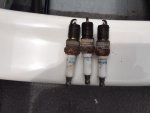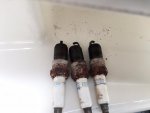No such thing as checking WOT on muffs or in a shop. Can't be done without the boat being dropped into a tank or floated. I s'pose a shop could hook up a dyno, but never seen one done for less than a race boat. Big dollar facility and limited usefulness.
The only test that matters at WOT is putting the engine under full load, horsepower to water. No way to do that without either dropping it in the drink or attaching to a dyno.
RIck
Thanks Rick - understood. Haven't tried to do WOT on muffs. I was out on the river yesterday testing her out.
Since I know this thread is on page 5 - a recap of current symptoms and what I have done to resolve.
Symptoms: Engine starts with no issues. Overall running is a little rough. You can feel it - especially in low RPMs, but this is not reflected greatly in the tachometer. The RPMS are not steady, but they do not fluctuate much - for example - it idles at about 600-650 and seems to surge back and forth as opposed to idling smoothly. With the boat in the water and I throttle down to WOT, instead of jumping up and running like the scalded rat she should, she starts moving, but seems to labor at first. The RPMS go up to about 2200 - stay there for a few seconds, and then start climbing and she starts moving as she should. The RPMS get to about 4100 but are not steady. They will fluctuate between about 3500 and 4100 at WOT with no change in throttle position. The engine did backfire 2-3 times while at higher RPMs yesterday while running on the river. There is no real bad smell of gas in the engine compartment. I am still not sure if the engine sounds normal or if there is a little hiss still remaining when it is hot indicating the TKS may not be functioning properly. Video above is of engine when warm.
While checking the oil yesterday - on the water and anchored - I found it to be about 3 quarts high. I definitely did not put three extra quarts in there - so I pulled in, removed about a qt and a half and re-launched the boat. Same symptoms as above. Oil removed does have a gas smell and is thinner than it should be, leading to the though that there is gas in it. It also explains the excess oil level. The boat is a 2008 Mercruiser KS Carb 4.3L boat with an electric fuel pump.
What I have done so far:
1 - While on land on the trailer - pulled the plugs, and conducted a compression test. All cylinders were sat at 180 psi.
2 - Plugs were black indicating rich condition (pics above)
3 - Removed outdrive to locate missing exhaust shutter. Located and removed it. Reinstalled Outdrive.
4 - Replaced impeller and drive lube.
5 - Replaced fuel/water separator (twice) and inspected the inline fuel filter at the carb. It is plastic and was clean with no obstructions.
6 - Replaced anti-syphon valve.
7 - Verified - with engine off - that carb butterflies both open as the should when throttle is placed at WOT.
I have NOT yet:
- verified timing
- check fuel pressure under load. I am not sure how to accomplish this.
What should my next move be? Thanks!
.





















